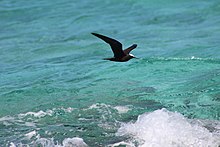White cap noddi
| White cap noddi | ||||||||||
|---|---|---|---|---|---|---|---|---|---|---|

White-capped noddi ( Anous minutus ) |
||||||||||
| Systematics | ||||||||||
|
||||||||||
| Scientific name | ||||||||||
| Anous minutus | ||||||||||
| Boie , 1844 |
The Weißkappennoddi ( Anous minutus ) or Weißkopfnoddi is a kind within the subfamily of the Noddiseeschwalben (Anoinae) in the order of the plover-like (Charadriiformes).
features
The white cap noddi, like all other noddis, has gray to sooty-black plumage with a sharply defined silvery-white cap. However, its plumage is slightly darker than that of the other two Anous species. The tail is wedge-shaped with a slightly tapered central control feather (tail feather) and there are small white markings on the lowered eyelid .
The maximum body length is 37 cm, the wingspan up to 76 cm.
behavior
Brooding
White-capped noddis breed in colonies in trees or shrubs. They lay their only egg in a self-made nest made of grass, roots and guano (sea bird droppings). The breeding season is between September and December.
Hunting / food
White-capped noddis hunt only during the day, from early morning until just before dusk.
The food mainly consists of fish , which the noddis grab from the surface of the water . However, they also grab small aquatic animals from the surf near the coast. They fly very quickly and with great agility.
voice
The white cap noddi harshly shouts "Kir" or rattles "Chor". A screeching “Krik-rik-rik” can sometimes be heard in flight.
Systematics
The white-capped noddi is one of the five species of the Noddise tern.
It is more closely related to:
- Ordinary noddi ( Anous stolidus ),
- Schlankschnabelnoddi ( Anous tenuirostris ),
- Blaunoddi ( Procelsterna cerulea ),
- Graunoddi ( Procelsterna albivitta ).
distribution and habitat
The Weißkappennoddi mainly inhabits seas, islands and keys ( coral islands ).
The distribution extends through all tropical oceans and the associated coasts.
The IUCN lists the species in the “ Red List of Endangered Species ” in the Least Concern category (not endangered).
Individual evidence
- ↑ a b c d e f g h i George Adams: Complete Guide to Australian Birds . Penguin Viking, North Sydney, NSW.
- ^ A b Francisco Erize, Maurice Rumboll: Birds of South America: Non-passerines: Rheas to Woodpeckers . Princeton University Press, Princeton, NJ 2006, ISBN 978-0-691-12688-3 .
- ↑ a b c Bikram Grewal, Sumit Sem, Sarwandeep Singh, Nikhil Devasar, Garima Bhatia: A Photographic Field Guide to the Birds of India, Pakistan, Nepal, Bhutan, Sri Lanka, and Bangladesh . Princeton University Press, Princeton, New Jersey, ISBN 0-691-17649-3 .
- ^ A b Jon Lloyd Dunn, Jonathan K. Alderfer: Field Guide to the Birds of North America . 7th edition. National Geographic, Washington, DC, ISBN 978-1-4262-1835-4 .
- ^ A b Peter Ryan, Norman Arlott, Peter Hayman, Alan Harris: Birds of Africa - South of the Sahara . 2nd Edition. Struik Nature, Cape Town 2010, ISBN 978-1-77007-623-5 .
- ↑ Black Noddy. IUCN, accessed May 17, 2020 .


